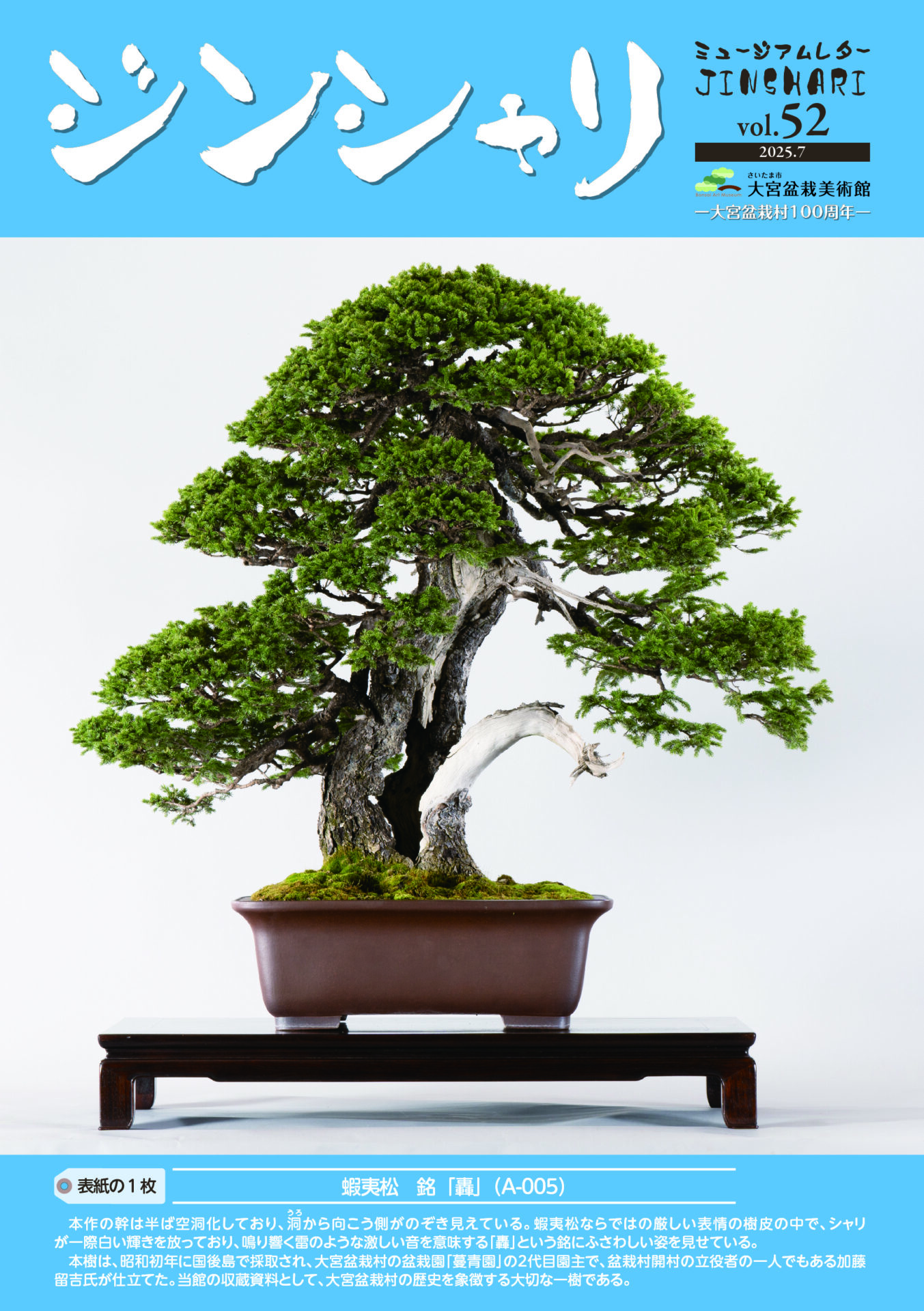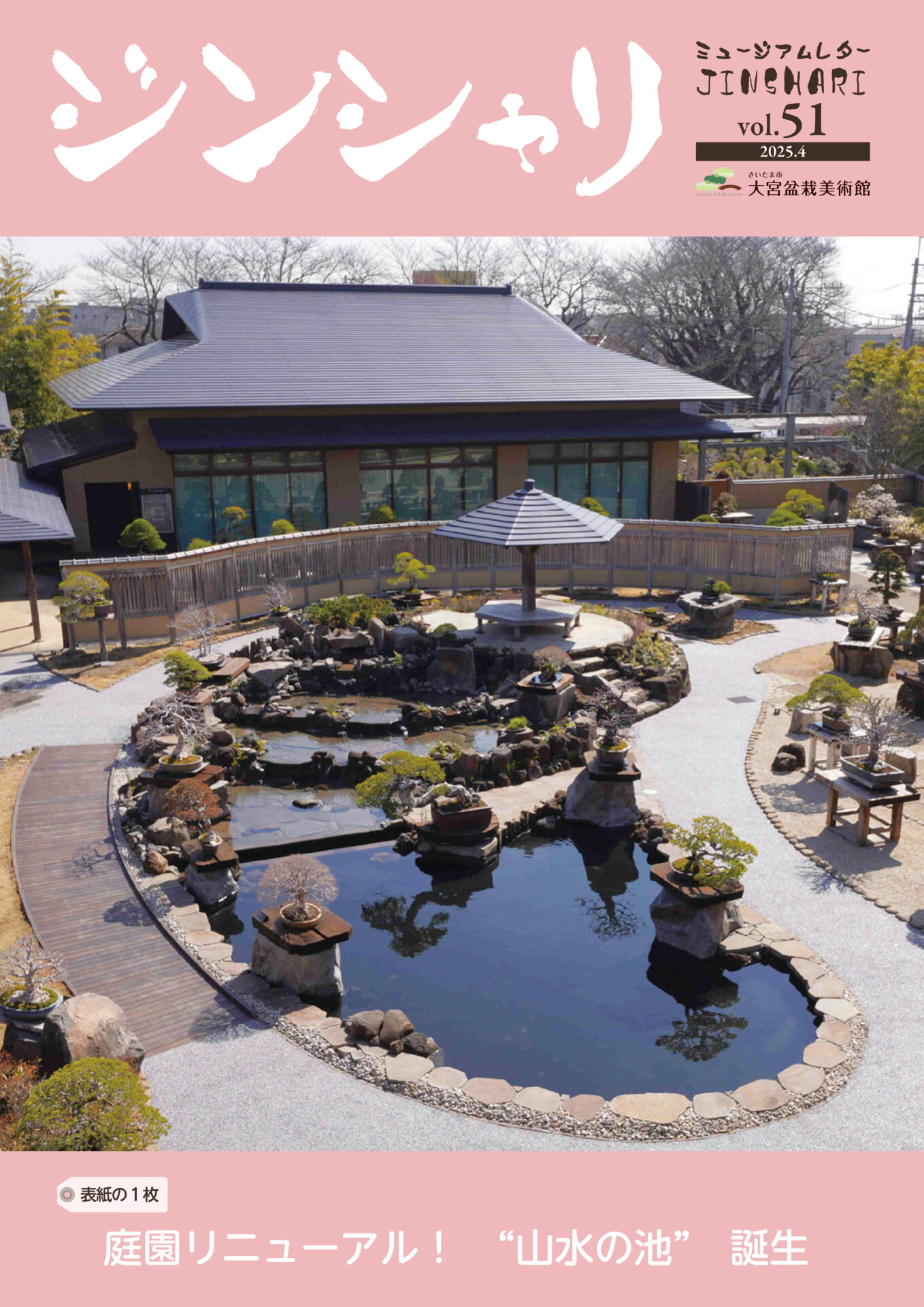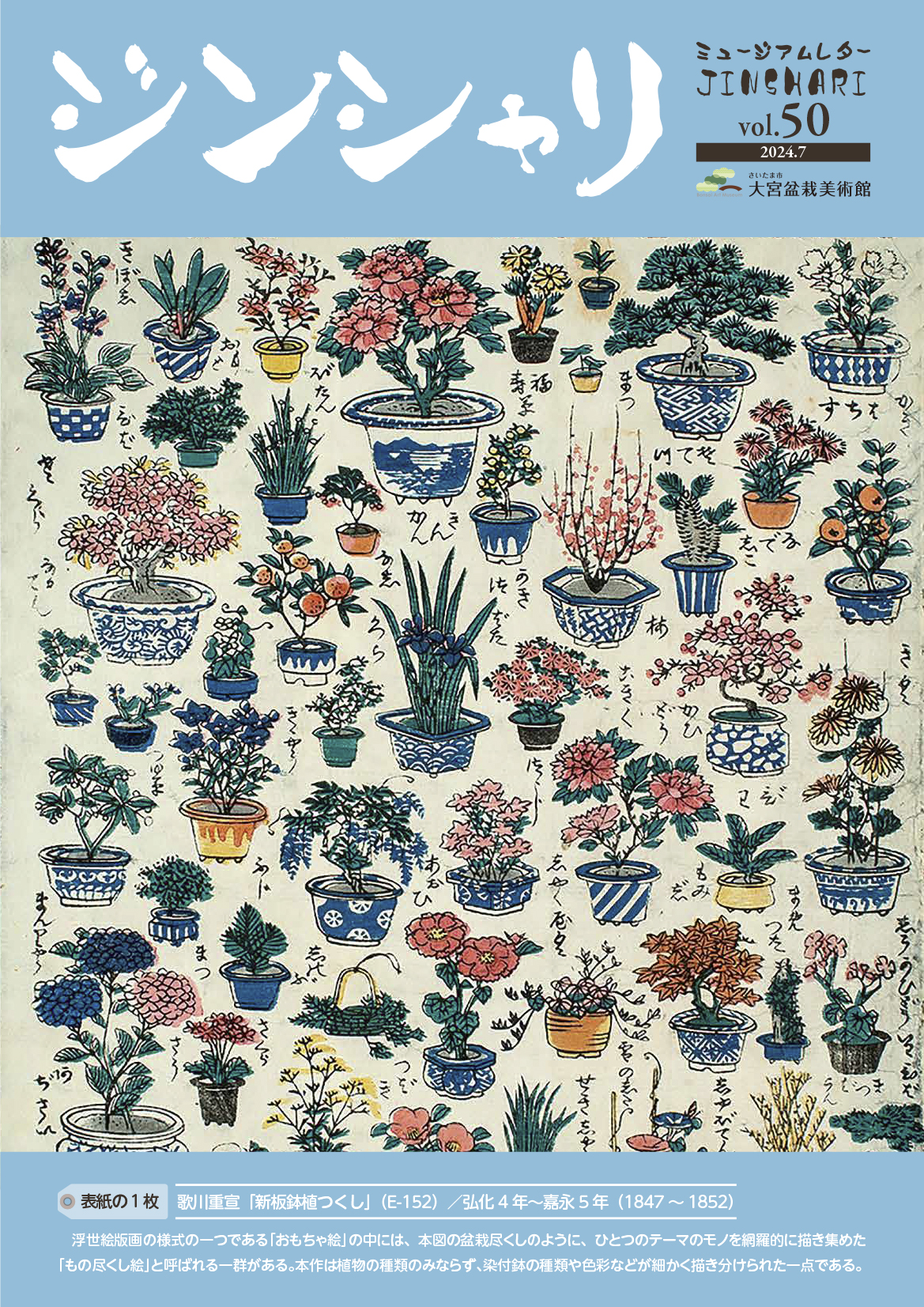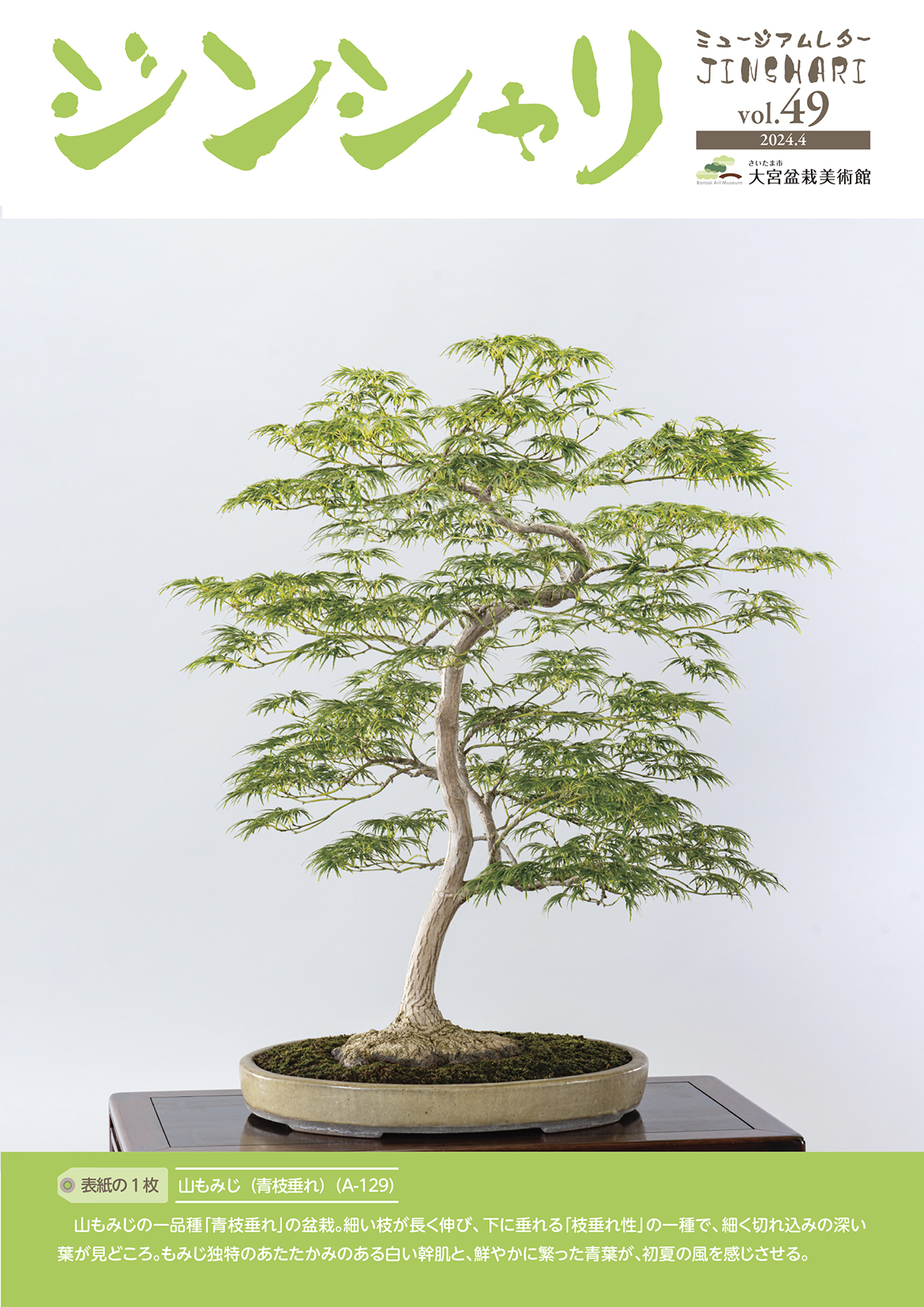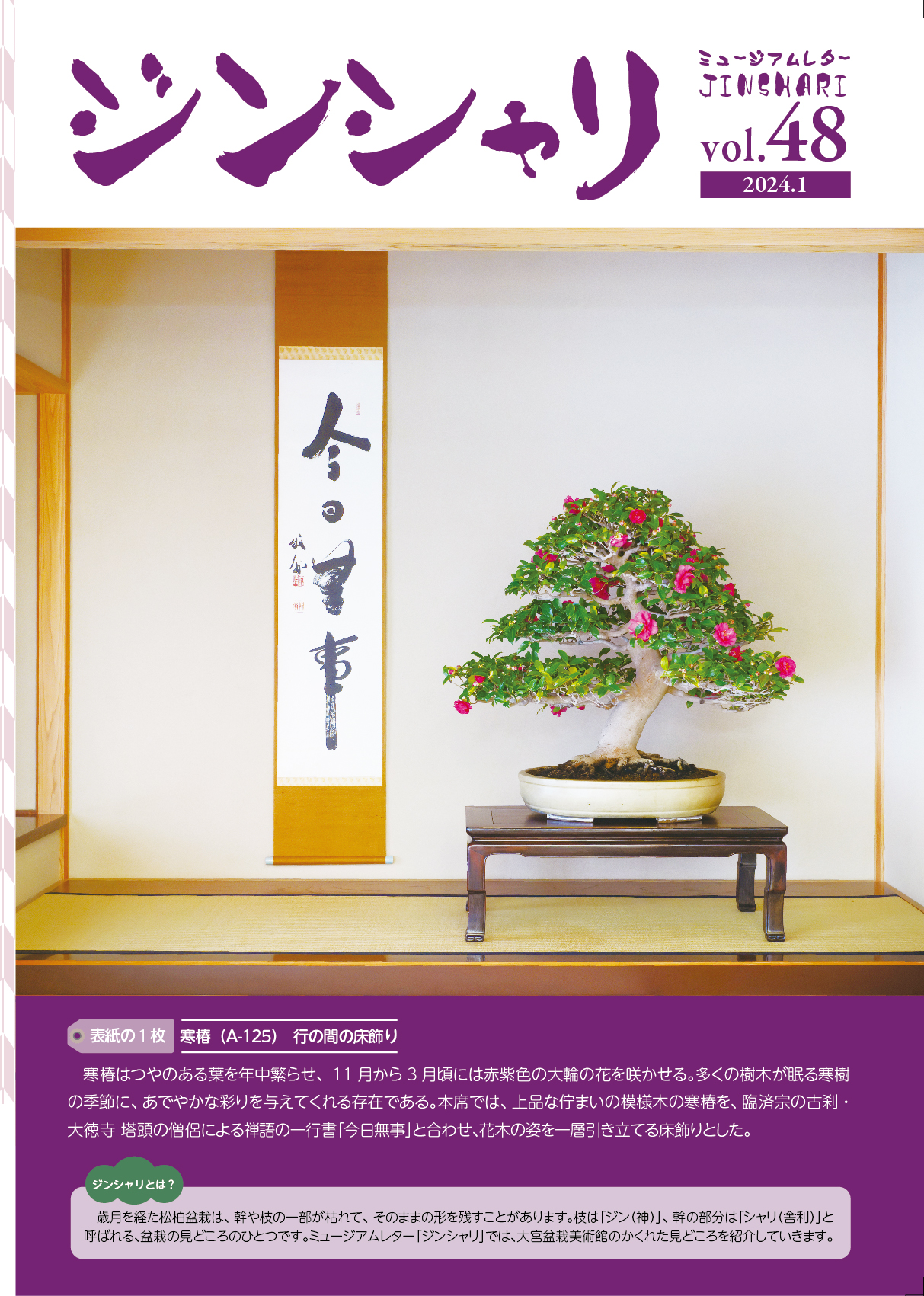Jinshari Vol.48
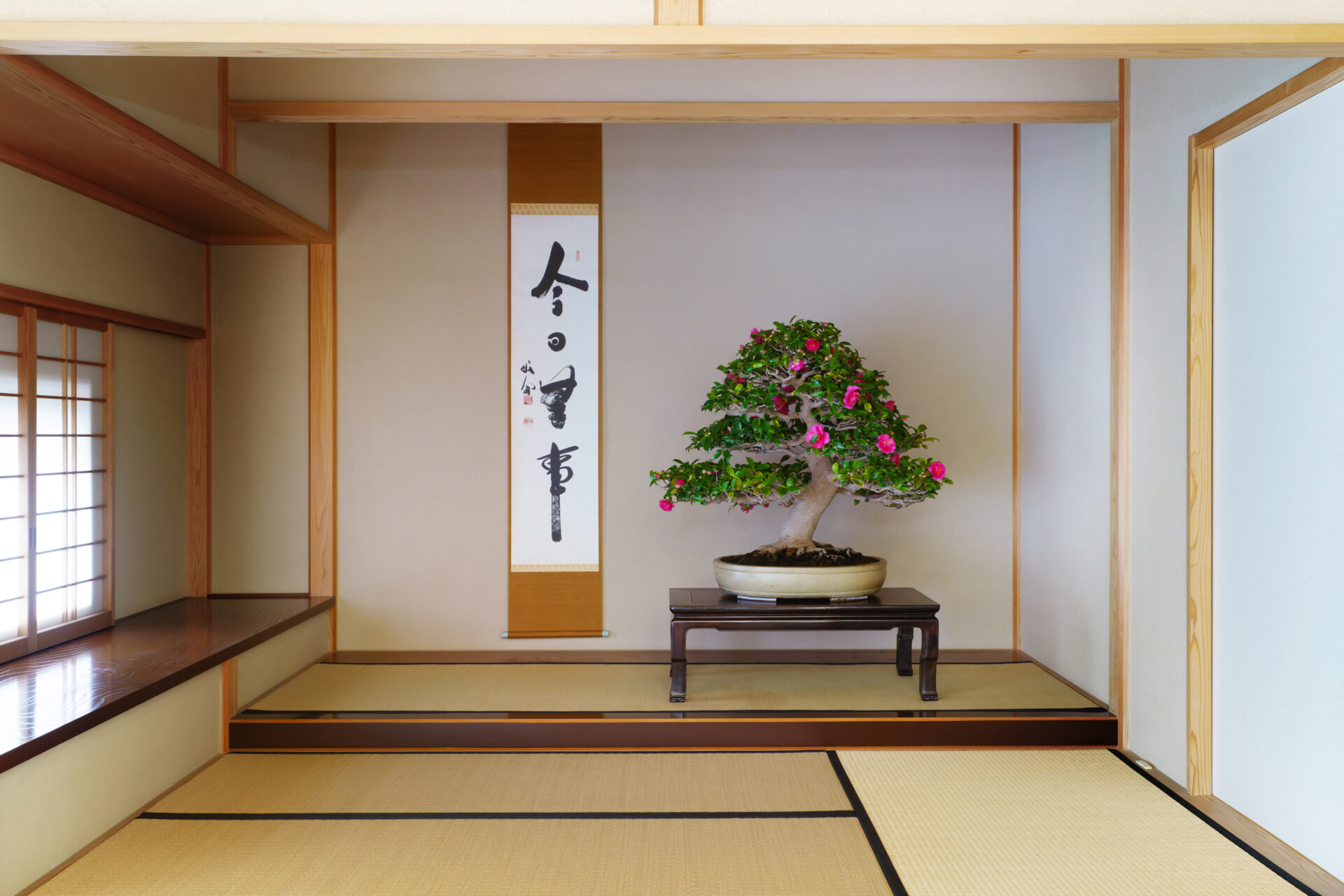
-
【Front Picture】Japanese Camellia (A-125) Decorated in a Gyo Tokonoma Room
The Japanese camellia has lush foliage all year round. From November to around March this tree blooms with large, splendid crimson flowers. It gives a vibrant, colorful presence in this season where many trees show their bare winter forms. This decoration of this room takes a camellia with an elegant form and pairs it with a piece of calligraphy that reads “Konnichi Buji”, meaning “no concerns today”. This is a Zen Buddhist word from a monk of a tacchu in the ancient Rinzai school temple Daitoku-Ji. This room decoration helps this flowering tree to stand out even further.
Estimated Age: 50 Years
https://www.bonsai-art-museum.jp/en/collection/a-125/
Behind the Exhibits
Special Exhibition – Sencha and Bonsai~ The Dawn of Bonsai
The green tea (sencha) which we regularly drink today was brought to Japan from China at the beginning of the Edo period by the Chinese monk Ingen Ryūki. As sencha had more freedom in it compared to tea ceremonies which had become formalized, by the middle of the Edo period sencha was welcomed by Japanese zen priests and the educated classes and spread amongst the literati who held Chinese culture in high esteem.
In this special exhibition which will be held in February 2024, we will be looking at the large changes which occurred in bonsai due to the influence of sencha culture, and also the process of that change. So, in anticipation for this special exhibition, we wish to give you a sneak peek and introduce one of the changes that occurred to bonsai, “the birth of Zashiki Kazari”.
The arrangement that one can see in the “Front Picture” of a bonsai in a tokonoma (or an alcove in English), is one that can often be seen in period dramas and so is often thought of being the traditional way that people would display bonsai. However, originally people would not see bonsai displayed inside of zashiki rooms (also known as tatami rooms) such as this. The reason for this is because in Japanese culture the ground is viewed as being impure, which is why shoes are taken off when stepping inside. So, when did bonsai start being displayed inside of tokonoma? The answer to this lies in the sencha ceremonies which were often held by literati from the end of the Edo period until the Meiji period.
Illustration 1 documents a scene of an early sencha tea gathering. To us modern people, seeing a bonsai displayed in a tokonoma like this is not a strange sight. However, a bonsai displayed in a tatami room - and in a high class tokonoma at that - is something which was never done all throughout history. The sencha tea gatherings of the literati gave bonsai a new home.
Of course, we can also see from a famous tea gathering held at around the same time in 1876 (as shown in illustration 2) that there are examples of bonsai being displayed outside, on external corridors, or inside of the tatami rooms. From this, it seems that the tokonoma was not the only place where bonsai were displayed. During this special exhibition, we will be taking a dive into the changes that took place in bonsai and how these changes took place, bringing us close to the background that created modern bonsai. Please take a look.
Exhibition Period: Sat. February 2, 2023, ~ Wed. March 20, 2023
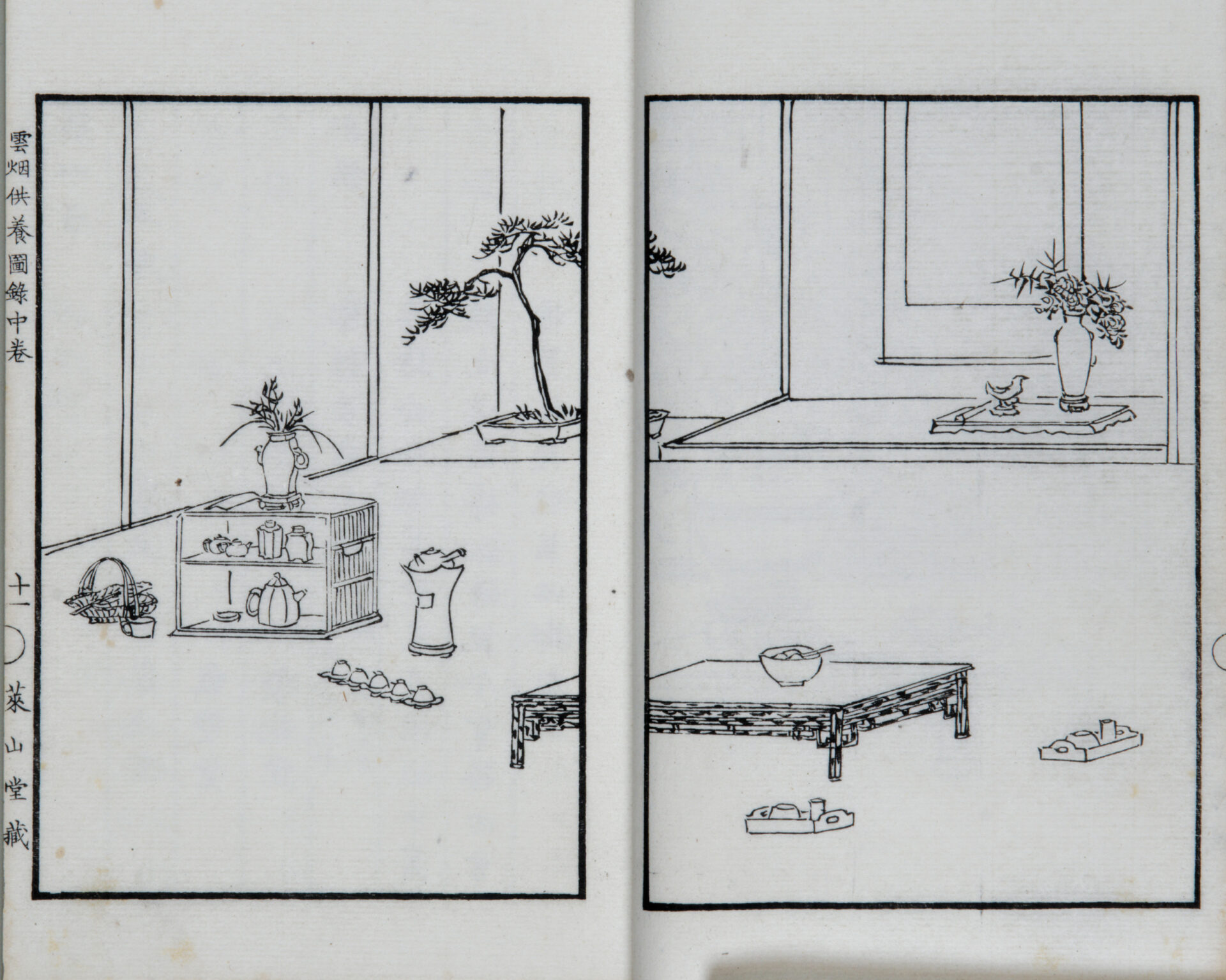
Illustration 1 "Unen Kuyo Zuroku", 1880
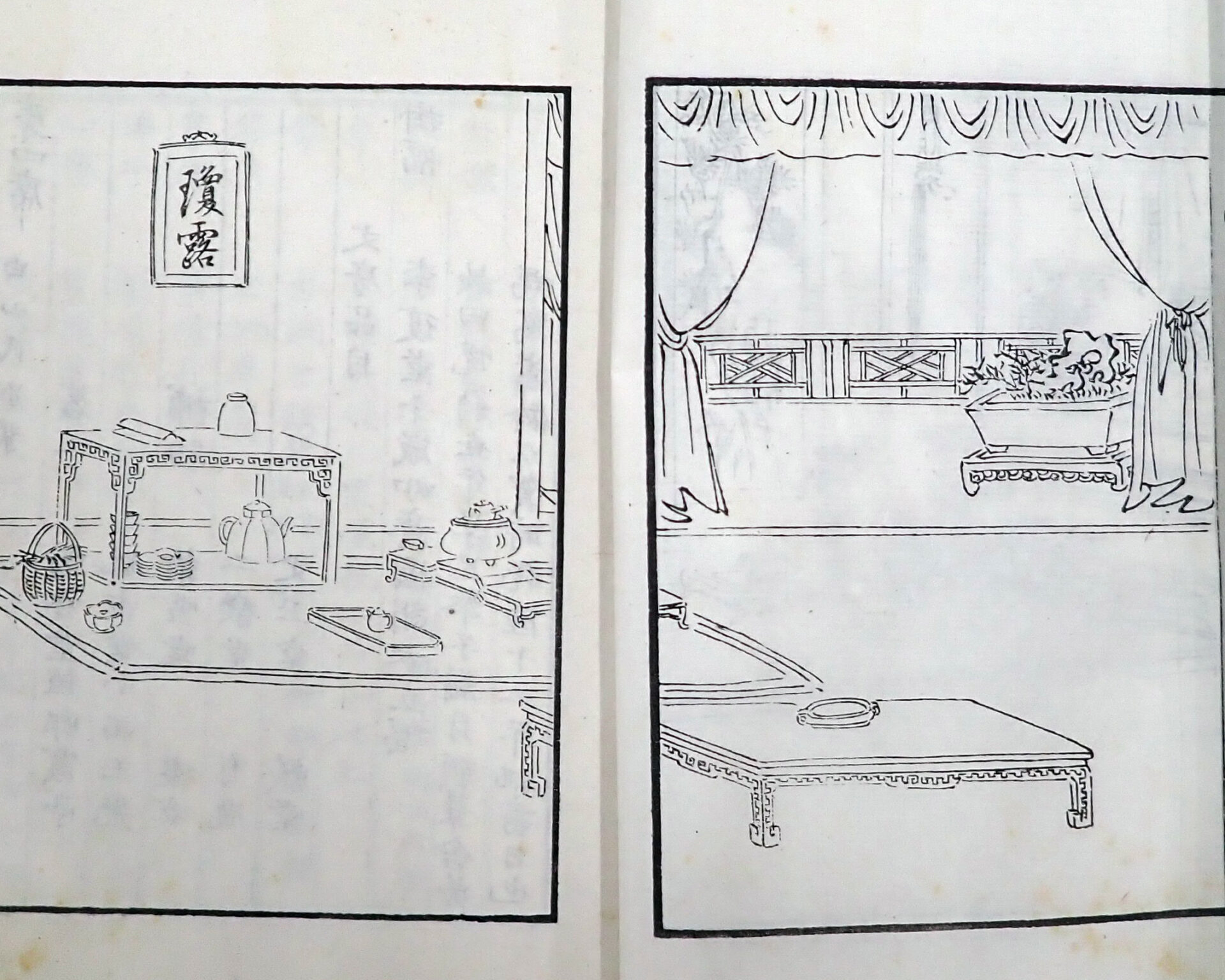
Illustration 2 "Seiwan Meien Zushi", 1876
Special Exhibition – Sencha and Bonsai~ The Dawn of Bonsai (Under Construction)
Artist’s Work
Wrapping in Blankets; Protecting the Bonsai and the Pot
In the winter trees will become inactive and go dormant. However, bonsai artists do not have any dormant period for their jobs. In this issue I hope to introduce techniques we use to protect bonsai and bonsai pots from harsh cold weather such as wrapping them in blankets.
In the Kanto region bonsai, with the exception of southern species that do not fare well in the cold, are cultivated outside. Trees such as the Japanese white pine and the Ezo spruce which grow naturally in alpine and cold environments are strong against the cold and are resilient, however the water inside of the soil can freeze and expand, breaking the pot that those trees are kept in. In the bonsai world this is referred to as “iteware”, meaning freeze crack.
We at the Omiya Bonsai Art Museum keep many of our bonsai in pots with historical value, so we take measures in order to protect each one while properly checking all of their conditions. Particularly, pots that were repotted into a number of years ago are more likely to freeze and crack as the bonsai inside will have spread its roots throughout it, which increases pressure inside the pot. So, for pots like this, more care is needed.
At the museum we will generally begin wrapping bonsai in blankets when it becomes frosty at 3℃. After the museum closes, we will wrap the bonsai in blankets. We will then take these blankets off the following morning before the museum opens. We repeat this process every day until spring comes. When wrapping the bonsai in a blanket, we take every precaution necessary, such as being careful not to break the branches or the jin and shari, and we tie the blanket down with rope or rubber bands so that they do not blow away in the wind.
Furthermore, the trees themselves may be damaged on especially cold todays, so we also take measure to prevent this such as moving the outdoor bonsai under the eaves and into our cultivation area. We also will make sure that we prioritize the bonsai in different ways such as holding back on watering them in the afternoon to prevent freezing and putting them in them in direct sunlight to heat them up. While the museum is open, visitors cannot see our bonsai curled up in a blanket like person would be, so please take a look at this picture of one of our bonsai being carefully taken care of.
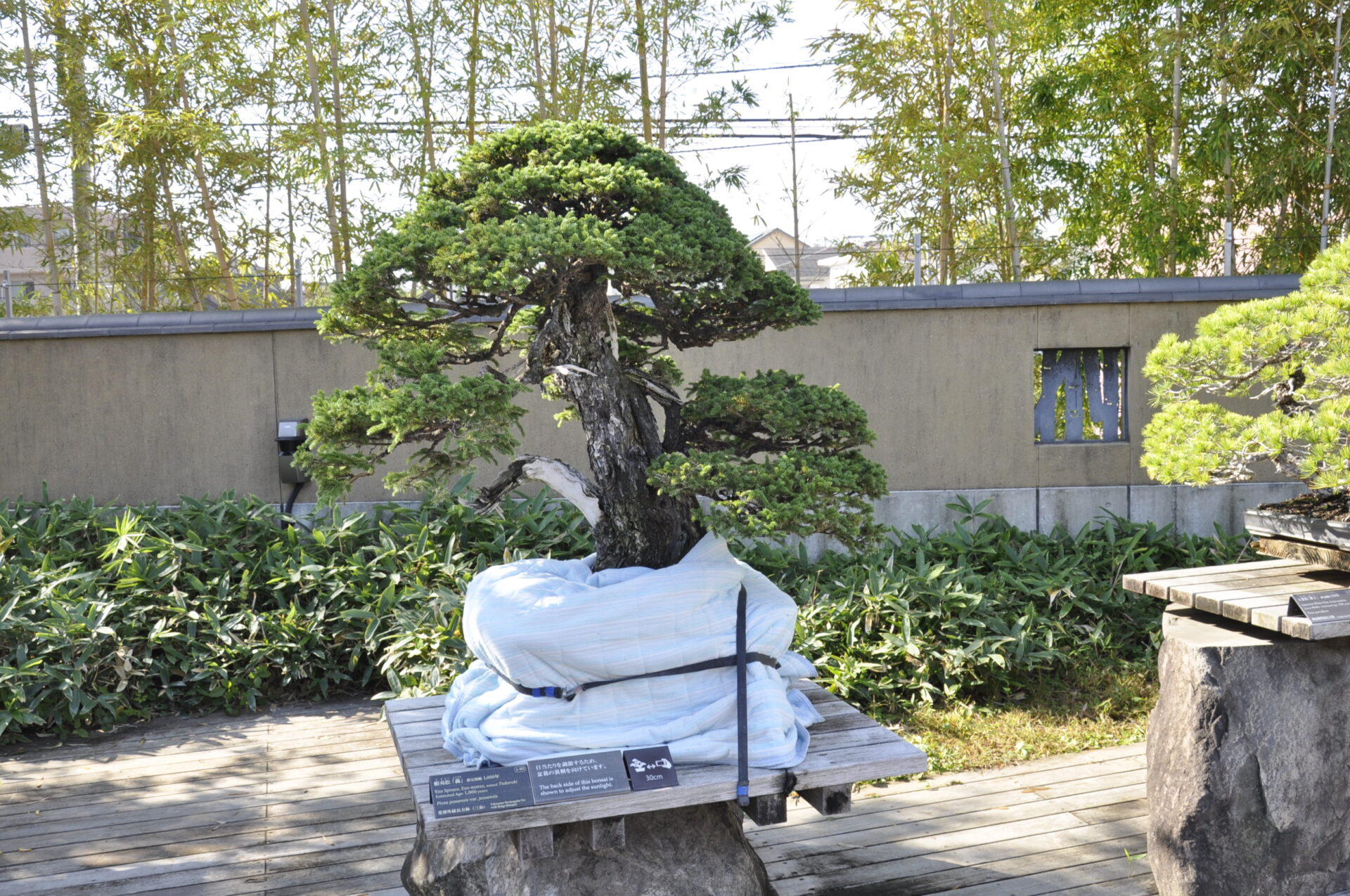
Ezo Spruce named "Todoroki" A-005 Wrapped in a Blanket
Supporter Reporter
“I am glad I came to see and listened. I want to come back and tell others” - Guides
【Numerous events at the Omiya Bonsai Art Museum are ran together with the Museum Supporters, a group formed by volunteers. In this issue, a Supporter will tell us about guides, one of the 5 activities which the Supporters take part in. 】
・・・・・・・・・・
We supporters run guides for domestic and international visitors to the museum. These are for both private and group visitors.
As restrictions for the spread of infection have been loosened, we have started expanding our activities such as starting “Welcome Monday”, a regular guide on Mondays, and also accepting guides for groups.
In our guides we will explain how to appreciate bonsai, teaching guests about how view them, what to look out for in each piece, the types of trees, their styles, how to look after them and also about the history of the bonsai village. We are also careful to give guests time to view bonsai freely during our guides.
Comments from visitors such as “I understand how to enjoy bonsai much more now. I want to come again” are encouragement. Also, by viewing bonsai together with visitors, we also can discover something new.
Bonsai can be enjoyed in different ways at different times of the year, such as the flowers of apricots and cherry trees and the budding of maples in spring, the green colors of pine bonsai in summer, the reds of autumn, and the sparkling drops at the end of delicate zelkova branches in winter. How about viewing bonsai in each four seasons with us supporters and become our bon-friends?
Supporter - Yukihiro Eriguchi

A Group Guide of 24 people from October 13. The group was split into 2.
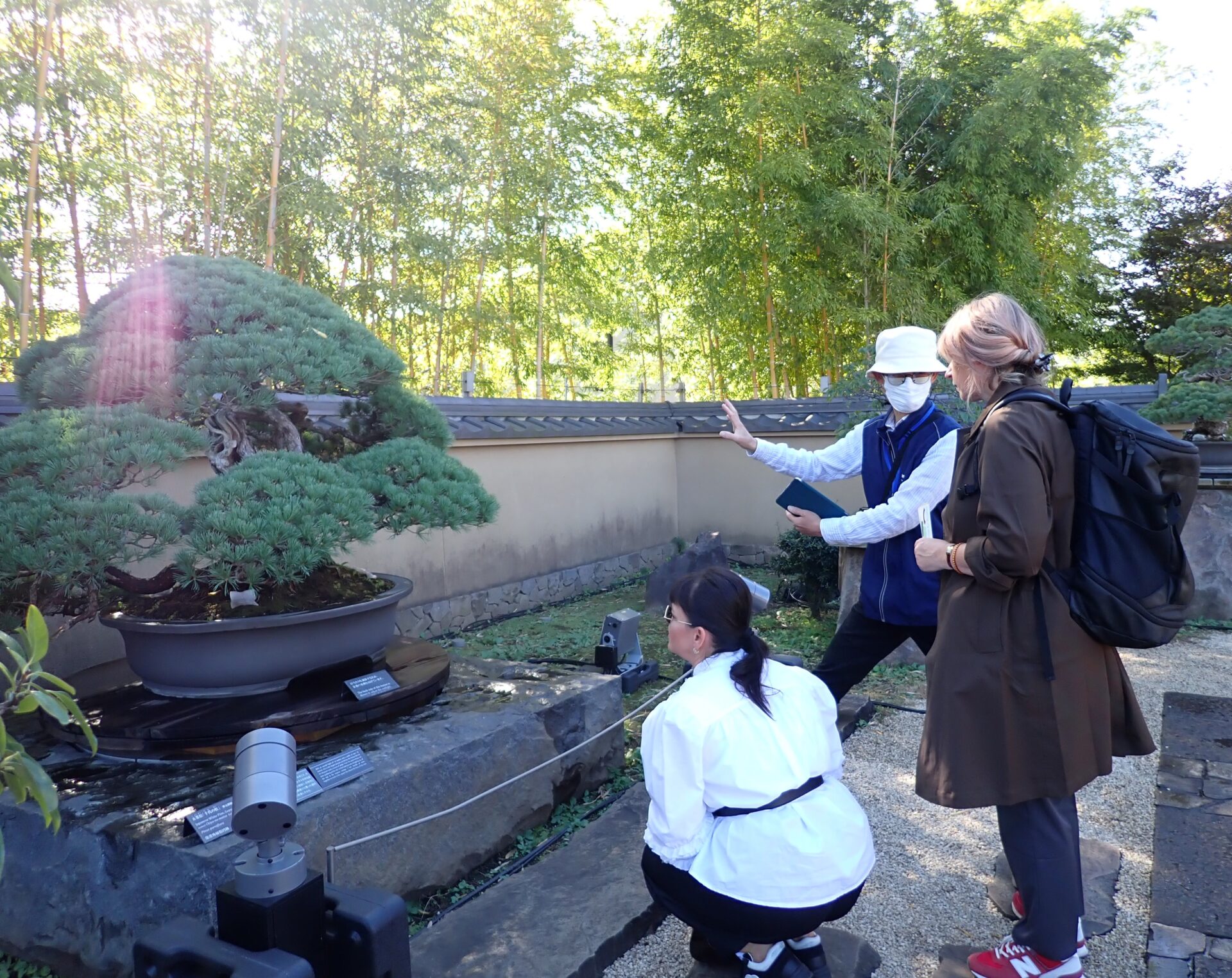
Welcome Monday Bonsai is also very popular abroad. The number of international visitors have increased.





